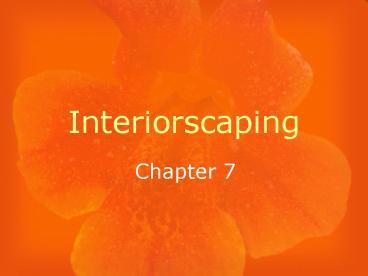Interiorscaping - PowerPoint PPT Presentation
1 / 31
Title:
Interiorscaping
Description:
Plant pathogen living disease causing agent. Examples are bacteria, ... localized dead areas in bark and cambium tissues of twigs, branches, and trunks ... – PowerPoint PPT presentation
Number of Views:100
Avg rating:3.0/5.0
Title: Interiorscaping
1
Interiorscaping
- Chapter 7
2
Causes of Infectious Plant Diseases
- Plant pathogen living disease causing agent
- Examples are bacteria, viruses, fungi, nematodes
- Most are microscopic
- Parasites living on the plant
- Causes abnormal processes
3
Diseases vs. pathogens
- Diseases do not spread from plant to plant
- Pathogens do spread
4
Naming of plant disease
- Plant most commonly affected
- Plant part affected
- How the part is affected
- Name of pathogen
5
Disease triangle
- Host plant that is susceptible to the infection
- Pathogen itself
- Environmental conditions that are favorable
6
Control of disease
- Nature of the agent
- How Long has the disease been present
- What control measure economically feasible
7
Control principles
- Exclusion to prevent pathogen from being
introduced - Eradication elimination of the pathogen from an
area - Protection placement of a protective barrier
between plant and pathogen (fungicide) - Resistance use of plants that are resistant to
pathogens
8
Exclusion and resistance practices
- Purchase pathogen free plants
- Acclimation and installation care plants not
weakened - Eradication discard and replace infected plants
9
IPM
- Integrated pest management using more than one
practice to control diseases
10
powdery mildew
- Powdery mildew A. violet, begonia, grape ivy,
jade plant, kalanchoe, mums - Look whitish appearance on leaf surface
- Leaf distortion, browning, crusty lesions
11
control
- Keep susceptible plants away from cld air drafts
- Never water late in the day
- Avoid drought stress
- Use appropriate fungicide
12
Anthracnose leaf blights
- Schefflera, aglaonema, croton, dracaena, hedera,
cissus, philo, pothos, monstera, - Spotted or blighted areas on leaves petioles,
stems, brown with tiny black spots - Bulls eye look on tissue
13
control
- Resistant plants
- Plant spacing
- Irrigation
- Soilless media
- Handling procedures
14
Fungal leaf spots
- Dracaena, sansevieria, yucca, palms
- Spots can be reddish brown on young foliage, dry
rot, cankering at the base of leaves - Can look like fluoride and high soluble salt
damage - Spots also brown to black, sunken and purple
margin
15
control
- No splashing of water
- Trim out infected areas
- Disease free material
- fungicides
16
Root and crown rots
- A. violet, aglonema, hedera, cissus, syngonium,
pilo, schefflera - Wilted foliage, yellowing, drop off, blackened
and softened roots - String like roots
17
control
- Good drainage of media
- Fungicides
- Sterile media used
- Leach to rid of soluble salts
18
Soil borne pathogens
- Pythium
- Phytophthora
- Cylindrocladium
- Wilting, yellowing of lower leaves
19
control
- Disease free plants
- Favorable root environment
- Soil free growing media
- Integrated maintenance
- Soil drench fungicides
20
Canker and dieback
- Caused by fungi that produce localized dead areas
in bark and cambium tissues of twigs, branches,
and trunks - Dead tissue is oval to elongate, 1-2 inches to 1
long - Takes many years to develop
- Girdling then decline, dieback, death of branch
21
Plants affected
- Dracaena
- Araucaria
- Ficus
- Spathphyllum
22
control
- Stress management - imbalances
- Wound infections
- fungicides
23
Bacterial diseases
- Spread from a point of infection
- Leaf spot or stem lesion
- Water-soaked
- Oily spotting
- Blighting of foliage
- Yellow halo with brown center
- Leaf yellowing
- Soft rotted area, with odor
24
control
- chemical protectants
- Picking off diseased plant parts
- Tissue-cultured propagated plants
- Sanitary growing conditions
- Spread from plant to plant by hands, tools,
splashing water
25
Virus diseases
- Exist in living cell of plant
- Tiny bodies, that infect, multiply,
- Abnormal green and yellow patterns in leaves
- Mosaics, ring-spotting, yellow spots with rings,
distortion of young leaves, veins thick and
translucent
26
control
- Show up in cool weather
- Will disappear in hot weather
- No chemicals available
- Good insect control
- Good cultural practices
27
Susceptible plants
- Mosaic virus on dieffenbachia
- Mosaic virus on Maranta
- Ghost Ring on Schefflera
- Spotted wilt virus on many plants
28
Nematode diseases
- Tiny microscopic roundworms
- Plant parasites causing disease
- Cause dead, brown to black areas between leaf
veins - Worse on older foliage
- Root feeding nematodes overall poor plant health
- Plant stunting, yellowing, tiny root swellings
29
control
- Nematicides
- Remove any specimens infested
- Avoid splashing water
- Do not use soil probes or shovels without
disinfecting
30
Susceptible plants
- Foliar nematode on Ficus, begonia, peperomia
- Root knot nematode on Schefflera, Pothos,
Maranta, Philos, Sansevieria - Burrowing nematode Chamaedorea, Maranta, Philos
31
conclusion
- There are many diseases that affect indoor plants
- To know for sure, have a sample tested by a
laboratory































